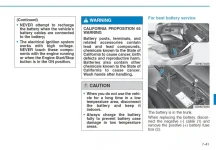digmyGenesis
Registered Member
CAR: 2015 Genesis Sedan 3.8 Technology AWD Canada
Do I really need to remove the battery before I can charge it? This seems crazy. The manual is not very clear.

I want to charge the battery from the + and - connector under the front hood. But the manual says:
NEVER attempt to recharge
the battery when the vehicle’s
battery cables are connected
to the battery.
What am I missing? I guess I need to disconnect the battery to be able to charge it. ?
Do I really need to remove the battery before I can charge it? This seems crazy. The manual is not very clear.

I want to charge the battery from the + and - connector under the front hood. But the manual says:
NEVER attempt to recharge
the battery when the vehicle’s
battery cables are connected
to the battery.
What am I missing? I guess I need to disconnect the battery to be able to charge it. ?









